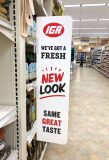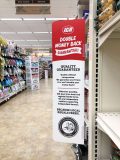by John Ross, president and CEO of IGA
Your inboxes likely are filled with looks back at 2020 and reflections on all the craziness that ensued. Instead, I want to look forward to 2021 and the years ahead in our industry.
Using insights from our stores in China, which has been dealing with the coronavirus longer than any other country, and research from multiple sources on changing shopper behavior, here are my predictions for the grocery industry – and independents in particular – over the course of the next several years.
First half of 2021
The COVID-19 virus and vaccine will continue to dominate headlines. Consumers will stay polarized, with some fearful of both the disease and the vaccine, and others anxious to get it all behind them. Conspiracy theories will continue, but their entertainment value (and credibility) will fade as consumers move on to something else.
For the grocery industry, this means episodic outbreaks in some local communities. Comp sales will continue to be positive in January and February, but as we lap virus effects, will have to compare 2021 to 2019 to get a real read on if we are growing or losing share.
I encourage you to set up a comp sales chart, as knowing if we are growing or losing share is critical.
 A return to restaurants?
A return to restaurants?
Over half of consumers will warily return to restaurants and dining out, but many smaller chains won’t make it. Total dining capacity likely is to be contracted through the end of 2021 and into the following year, though eventually restaurateurs will see pent-up demand and reopen or start new restaurants.
Invest in prepared foods
Grocers who take this time to up their game in deli and prepared foods will reap long-term share. A local grocery store’s prepared foods are the freshest sources of complete meals in town.
Innovate here: start new fresh menu options, build a sandwich program, invest in talent (which is out there, right now still struggling to find employment in restaurant and hospitality).
Hire a chef and let him or her see how much nicer it is to work a regular schedule in a grocery store rather than the late night/long hours in restaurants. Give the chef the latitude to build a cool local breakfast/lunch/dinner solution.
Manufacturer partnerships
Manufacturers will be anxious to ramp up volume. There will be an odd period of escalating sales in dine out, but strength in grocery. Brands that invest in grocery channels will reap big rewards, as millions of consumers now know how to cook and shop in ways they didn’t before.
E-commerce remains strong
E-commerce will stay solid, even as we lap the panic buying of spring 2020. Grocers who haven’t done so can still get in on the action, but that window is tightening. E-commerce shoppers are more likely to stay loyal to their grocer, less likely to deal-shop, and more likely to expand baskets into meat and produce.
Back half of 2021
As the vaccine starts to reach more consumers, many will flock to restaurants. About a third of Americans say they are anxious to get back to dining out; 25 percent say they won’t go back to cooking at home when it is safe to eat out.
Cooking at home here to stay
Most Americans say they will continue to eat food cooked at home. They have learned new skills, how to save money and make healthier food for their families. The majority of Americans say they will eat out less than they did before the pandemic.
Must earn shoppers again
Communities will be thankful for their local stores, but the hero image of the hourly cashier risking their health to help their community will fade. Local grocers will once again have to earn shoppers based on service and quality, not just fear that bigger chains are less safe.
Investing in décor, marketing
The good news? Now is the perfect time to reinvest in your store. New signage, a fresh paint job and fixing broken ceiling tiles and flooring go a long way. According to Invista 2020 research, new décor has been creating 1 to 3 percent comps on top of the COVID bump.
The research also says that new signage and updating a brand pleases shoppers, with more than half saying they think a store that updates interiors also buys healthier food.
Retailers who take the time to re-evaluate messaging in-store and in their advertising will sustain share. Shoppers loved knowing they were shopping a local family chain during COVID, so pulsing up messaging like “local” and “independent” will pay dividends for years.
CPG brands will innovate
Expect to see a rash of innovation from CPG brands in 2021. Many brands delayed new products during COVID-19, so there will be a backlog of cool items hitting shelves. Also expect to see manufacturer discounting and national promotions accelerate. Brands will need to earn spots on shelves, and in some cases, re-earn them.
Provide value-focused solutions
 It will come at a good time. Artificial government stimulus will have expired by summer, and the realities of our bifurcated economy (some industries surging, others languishing) will hit many consumers hard.
It will come at a good time. Artificial government stimulus will have expired by summer, and the realities of our bifurcated economy (some industries surging, others languishing) will hit many consumers hard.
Retailers and brands need to be thinking ahead to packaging value as a part of their marketing – not as a gimmick to increase temporary share, but as a sustained service to help them keep their families fed.
I am not talking about running our normal sales ads here. Instead, think about how you can package meal solutions and harness private label with CPG deals to make meal dollars to help families. Need will vary and, as always, it will be intensely personal and local – everything IGA does well.
E-commerce becomes norm
E-commerce will become a normal part of most retailers’ core operations. By the end of 2021, most will have figured out how to serve online shoppers. Retailers who don’t invest in e-commerce now may find they missed it.
Trying to build a digital relationship in the future will be costly, as you will be forced to buy back online shoppers from other retailers. By year end, online grocery will run over 5 percent nationally, but in many communities it will be much higher.
Locally owned stores in resort communities or with older consumers will figure out how to market to individuals who don’t want to or can’t easily get into our stores. Once connected to e-commerce, retailers will discover that these shoppers are intensely loyal.
2022 and beyond
With COVID-19 behind us, you might expect shoppers to go back to their old ways. But issues of safety and health will stay with us for a very long time. Expect healthy eating, safety and clean stores (and restaurants) to be critical decision-making factors when shoppers pick a store.
Clean, updated stores
Research has shown for a long time that when shoppers see cracked floor tiles, dirty restrooms or missing ceiling tiles, they assume the food is low quality. This new, health-paranoid mindset will intensify shopper fear for decades.
Retailers need to learn how to see their stores through the shoppers’ eyes. If a store is known as local, fresh and safe, it has a very bright future.
At a glance: The Independent Grocers Alliance provides marketing, branding and training resources that create more sales and profit potential for IGA-branded and non-branded stores alike. For more information, visit www.becomeiga.com.

